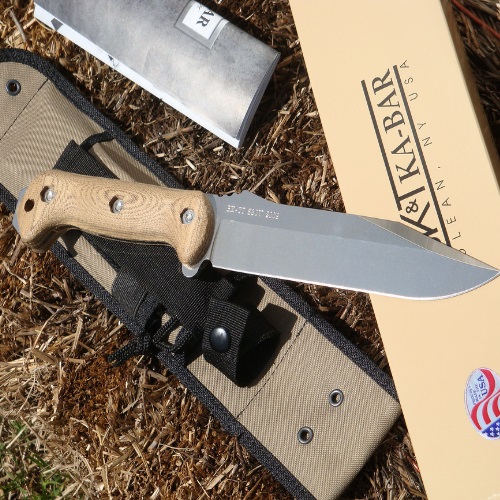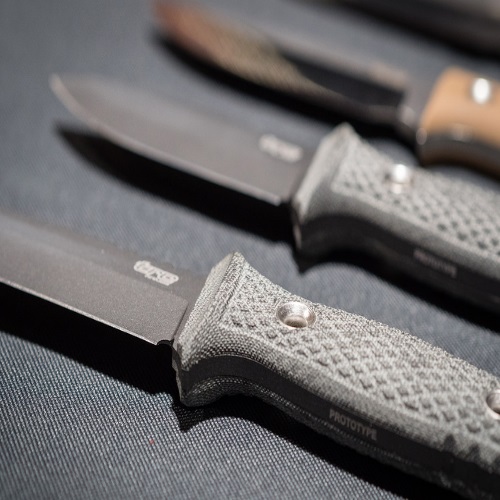Materials Overview
Getting a good grip on your knife is almost as essential as the blade itself. Obviously, the steel of the blade is the most important part of any knife. No one is disputing that. Without it, a knife is pretty much useless as a cutting tool. However, you could have a blade made from the best materials, but not be able to get a solid grip on it. That’s no good either, of course.
Many times, a knife is pulled during conditions which are less than perfect or ideal. First of all, there is the stress factor. You want a knife that will be able to perform, even in the hands of someone who is less than skilled. Second, the handle may become wet or slippery due to cold, heat, rain, seawater, blood, sweat, etc. For this reason, it is still very necessary to have a secure and reliable grip on a cutting tool. You don’t want to be in the middle of a delicate (or less delicate) cutting job, and have the handle slip or fly out of your hand. That is how accidents and mishaps occur, and when it comes to knives, well… let’s just say it is less than desirable.
Spyderco’s knives are made from a variety of different materials. Generally speaking, these can be broken down to three main categories: metallic, synthetic, and natural. Some of them were developed and enhanced by Spyderco itself, and others are considered classic or traditional handle materials. Here are our options for handle materials:
Spyderco Handle Material
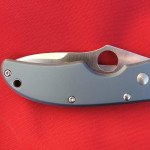
Almite
Almite is used as coating on aluminum handles, similar to anodizing (a metallic treatment). Spyderco offers a bunch of knives with almite. It can be made in many different colors which makes it popular with people wanting a custom looking knife. It can nick and scratch fairly easily so that is something to take into consideration.
Anodized Aluminum
Anodized aluminum is the product of anodizing the metal. Anodizing is a form of metal treatment which increases the surface of the metal. This makes the metal more resistant to corrosion. It also allows for paints and dye to stick to the metal better. Much like almite anodized aluminum can come in a plethora of colors.
Bi-directional Texturing
So named for the opposing steps which protrude outward from the handle’s center, it is a patented texture pattern which has been molded into fiberglass reinforced nylon (FRN). Although other knife companies have come out with their take on the bi-directional texturing Spyderco was the first. The texture at the front of the handle is made to prevent hand slippage forward onto the blade. The texture on the back is made to prevent your hand slipping off the knife entirely. Suffice to say it provides a grip like no others, and it is very secure.
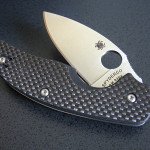
Carbon Fiber
This is a lightweight handle, but is very strong. It has a unique appearance, and it costs more than most handles, due to the intricate work that goes into producing it. Thin fibers of graphite are woven together, and then fused with epoxy resin (a kind of high-strength polymer).
Carbon Fiber / G-10 Laminate
Strong, effective, and all business, this handle consists of an outer layer of pure carbon fiber, bonded to G-10 base layer. This laminate makes for a very durable handle.
Fiberglass Reinforced Co-Polymer
Polymers are known as very resilient materials. This injection-molded substance, reinforced with glass fiber, is one tough handle. It is chemical and heat resistant, extremely lightweight, and versatile. Furthermore, this substance can be tinted with different colors, or even made translucent.
Fiberglass Reinforced Nylon
This substance is also very lightweight and strong. It is mainly used in the manufacture of textured knife handles. It is a nylon polymer, mixed with glass fiber that can be molded. Ideal as a handle or grip.
G-10
G-10 is one of the most popular knife handle materials today, in the man-made category. It is essentially an epoxy-filled woven glass fiber. Plainly speaking, that means that it is tough. Almost untouchable in everyday situations. Temperature changes and chemicals have no effect on it, and it can also be tinted into different colors.
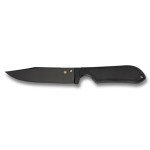
Kraton
This is a synthetic replacement for rubber, made by Kraton. Kraton material is elastic at its core, and it provides the kind of flexibility and abilities of natural rubber, but – unlike regular rubber – it has resistance to heat, cold, and chemicals, making it a perfect handle for many kinds of knives.
Micarta
Micarta is the name given to a composite of linen, canvas, or paper that is impregnated with epoxy resin (polymer) and formed into sheets or blocks. Often used in knife handles, it is lightweight, durable and very appealing aesthetically and visually. It is very versatile, and can take on different appearances and textures.
Natural Materials
Natural materials such as bone, leather, mother of pearl, and abalone. Some handles are made of wood and stones that are suitable for making handles. Natural material are also very commonly used to one-up a pre-existing handle.

Nishijin Glass Fiber
Harking back to the distinctive patterns of traditional Japanese nishijin woven textiles, this material is very similar to carbon fiber. Strong and rigid.
Peel-Ply Carbon Fiber
This is very similar to regular carbon fiber, but with an extra feature. During the manufacturing process, a textured protective layer is bonded to the handle’s surface. After the production of the handle is finished, the protective layer is peeled off, revealing a non-slip, high-traction texture which works very well as a handle.
Stainless Steel
This is a well-known material. Stainless steel is essentially a steel containing a minimum of 12% chromium. The chromium helps create a barrier which inhibits corrosion. This is what makes the steel resistant to corrosion, but not 100% immune to rust.
Titanium
Titanium is used in many kinds of kitchenware. It is one of the most popular non-steel metals around. It is very lightweight, very strong, and very resistant to corrosion.

Volcano Grip
One of Spyderco’s trademarks, which is used on several of Spyderco’s fiberglass-reinforced-nylon-handled knives. It is a continuous, waffle-like pattern of small squares with central divots. These provide resistance to slipping when gripped.
Choose Wisely!
Spyderco has a wide range of knife handle materials, and their products can be purchased online as well as at the Spyderco outlet store in Colorado. Occasionally, there is a release one an older or discontinued model as a limited-edition Sprint Run. In Sprint Runs, a different handle material and treatment is sometimes used.
A fun thing about knife handles is that they are something which is also DIY-able. Not everyone has a way to forge a knife, but certain materials are acquirable. There is nothing quite like fashioning your own knife handle, or embellishing on an existing one.
